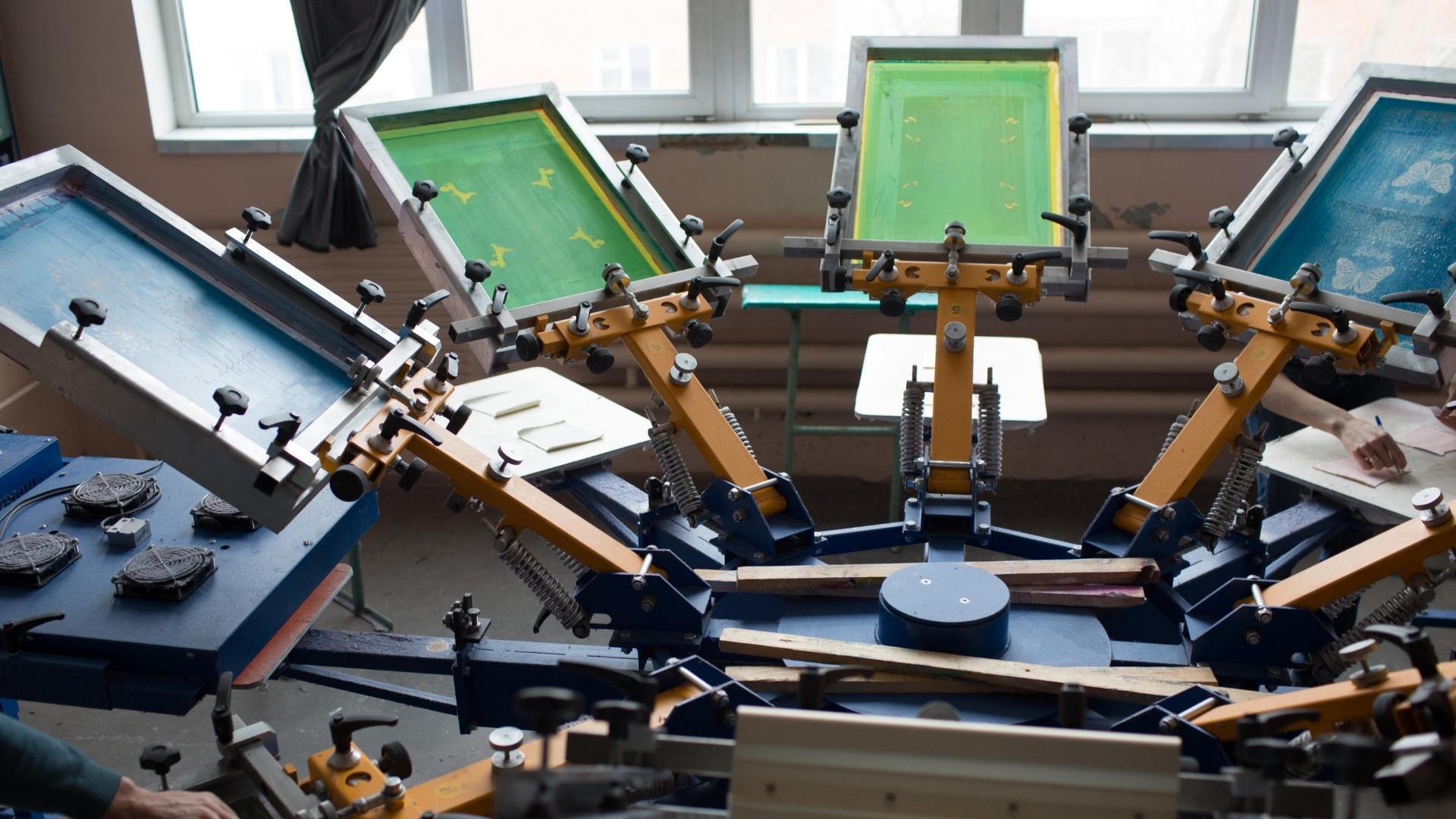From Style to Distribution: Grasping the Art of T-Shirt Screen Printing
The trip from layout to distribution in t-shirt screen printing incorporates a collection of critical points that demand focus to detail and strategic preparation. It starts with recognizing the nuances of your target audience, adhered to by the selection of proper products and the prep work of artwork that meets high standards. As the process unravels, obstacles in top quality control and logistics can develop, possibly influencing the final result. Exploring these intricacies exposes not just the complexities of screen printing yet also the crucial techniques that can boost a brand name's standing in an open market.
Comprehending T-Shirt Screen Printing
Comprehending T-Shirt screen printing entails recognizing a versatile and widely utilized technique for transferring designs onto material. This technique utilizes a stencil and a mesh screen to use ink onto numerous fabric materials, mainly cotton and polyester blends. The process begins with the production of a display that features the preferred layout, which is then carefully aligned on the textile.
Ink is pressed via the screen's open areas utilizing a squeegee, enabling for precise application of color. This technique is preferred for its capacity to create dynamic, long-lasting prints that hold up well to washing and wear. In addition, screen printing can accommodating both intricate and simple designs, making it a favored selection for custom apparel, marketing items, and also creative jobs.
Furthermore, screen printing uses scalability, making it suitable for both small batch orders and large productions. While preliminary setup expenses may be higher compared to various other printing approaches, the efficiency and toughness of screen printing typically warrant the financial investment. In general, recognizing the basics of Tee shirts screen printing is necessary for any individual seeking to involve in this preferred form of material decoration, whether for commercial ventures or individual projects.
Conceiving Your Design
Conceptualizing your design is a vital action in the Tee shirts screen printing procedure, as it establishes the foundation for the whole job (T-Shirt Printing). This stage entails producing concepts that reverberate with your target market while making certain that the design straightens with the brand name's identity and message. It is necessary to begin by discovering motifs, color design, and graphics that reflect the intended aesthetic
Laying out preliminary concepts can be useful, permitting for an aesthetic representation of concepts before settling the design. Think about using typography, imagery, and layout in a manner that captures focus and interacts properly. In addition, it is critical to prepare for the printing method that will certainly be employed, as this can affect design intricacy and shade options.
Taking part in conceptualizing sessions with group members or seeking feedback from possible consumers can also enhance the concept process, providing varied point of views that refine the layout. Inevitably, a well-thought-out design not only improves the visual charm of the T-shirt but also cultivates a connection with the audience, driving rate of interest and prospective sales. Consequently, dedicating time to conceptualize your style can lead to an effective screen printing end result.
Choosing the Right Materials

The weight of the textile, normally measured in grams per square meter (GSM), affects the drape and total feel of the T-shirt. Heavier fabrics might give a more premium look, while lighter choices fit for informal wear. Texture also contributes; smoother textiles often tend to generate sharper prints, while textured surfaces can create distinct aesthetic impacts.
Additionally, think about the environmental influence of products. Organic cotton and recycled polyester are getting appeal amongst eco-conscious customers. Inevitably, picking the ideal materials entails balancing aesthetic allure, capability, and sustainability, making certain that the Tees not just looks excellent yet also meets the expectations of your target audience.
Preparing Art Work for Printing
Preparing art work for T-shirt screen printing calls for careful attention to information to ensure that the final print properly reflects the designated style. The primary step is to produce a high-resolution electronic documents, ideally in vector layout, as this enables scalability without loss of quality. Usual software used for this function includes Adobe Illustrator and CorelDRAW.
Next off, confirm that all message is converted to lays out or rasterized to stay clear of font concerns throughout printing (Abilene T-Shirt Screen Printing Company). Additionally, it is essential to validate that the shade mode is readied to CMYK, as this aligns with the printing process. Pay attention to shade matching; using Pantone shades can aid achieve consistency across different prints
Take into consideration the dimensions of the print location and preserve proper margins to avoid style cutoff. It's also important to consist of registration marks for positioning during the printing procedure. Screen Printing. Request an evidence from the printer to envision the last product prior to mass manufacturing. This step is essential for determining any possible concerns, ensuring that the published Tee shirts fulfills the desired high quality and layout specifications. Appropriate prep work of artwork greatly affects the overall go to this web-site success of the screen printing task
Understanding the Printing Process
Mastering the printing procedure is important for accomplishing premium cause T-shirt screen printing. This stage involves a number of significant actions that directly influence the last product. The initial step is setting up the printing press accurately. Appropriate enrollment of displays assurances that colors align appropriately, preventing misprints and ensuring a professional appearance.
Next, picking the right ink is vital. Different ink types, such as plastisol or water-based, deal numerous surfaces and longevity. Understanding the fabric make-up of the Tees likewise assists in selecting compatible inks.
When it pertains to the actual printing, managing the squeegee stress and angle is important. Regular pressure will certainly produce even ink circulation, while the angle impacts the flow and insurance coverage. Additionally, readjusting the rate of the printing press can impact the ink's curing procedure, which is essential for assuring resilience.
Quality Assurance and Finishing
After the printing process is complete, applying efficient quality assurance actions becomes crucial to verify that each Tees satisfies the desired requirements. Quality assurance involves a methodical method to examining each garment for problems, confirming that the print high quality, color accuracy, and material integrity straighten with the requirements established throughout the design stage.

The initial step in quality control is a comprehensive aesthetic examination. This requires checking for common problems such as imbalance, ink smudges, or fading. Any T-shirt that does not fulfill the top quality criteria ought to be resolved quickly, either through reprinting or repair.
In addition to aesthetic checks, it is very important to conduct clean examinations on a sample of printed shirts to analyze the durability of the inks and the overall long life of the layout. These examinations aid verify that the print will certainly maintain its vibrancy and integrity after multiple washes, a crucial aspect for customer satisfaction.
Finishing touches, such as string trimming and the application of care tags, additionally play a significant function in top quality control - Screen Printing. By concentrating on these facets, businesses can boost the general presentation of their products, eventually causing a much more enjoyable client experience
Packaging and Delivery Solutions

To attain suitable packaging, take into consideration utilizing green products that align with sustainability trends, such as recyclable poly bags or biodegradable boxes. Each T-shirt must be nicely folded and put in safety wrapping to stop creasing and prospective damage throughout transportation. Consisting of a branded insert or care directions can even more individualize the experience, cultivating client loyalty.
Picking a reliable delivery companion is crucial when it comes to delivery. Examine alternatives based on expense, speed, and tracking abilities. Supplying numerous delivery techniques can deal with various customer requirements, from typical to expedited delivery.
Regularly Asked Concerns
What Are the Common Errors Newbies Make in Screen Printing?
Common blunders beginners make in screen printing consist of improper screen prep work, insufficient ink mixing, wrong direct exposure times, inadequate curing, and ignoring to check prints. These mistakes can bring about poor quality and poor outcomes in last items.
Just How Can I Avoid Ink From Blood Loss Throughout Printing?
To avoid ink bleeding during printing, guarantee appropriate screen stress, use appropriate emulsion density, choose the ideal ink consistency, keep perfect treating temperatures, and stay clear of overloading the screen with excessive ink during application.
What Kinds of Inks Are Ideal for Various Fabrics?
Selecting inks based upon textile type is necessary. Water-based inks are excellent for cotton, offering gentleness. Plastisol inks suit artificial fabrics, using sturdiness. Discharge inks successfully mix with natural fibers, ensuring dynamic colors without jeopardizing textile stability.
Exactly how Do I Choose the Right Screen Mesh Count?
Choosing the appropriate screen mesh matter relies on the wanted print detail and ink kind. 10:9 Design Business Branding Solutions. Greater mesh matters generate better details, while reduced counts help with thicker inks. Assess material kind and style complexity for perfect results
Can I Utilize Screen Printing for Tiny Set Orders?
Yes, screen printing can be properly utilized for small set orders. This technique enables premium results and comprehensive layouts, making it a feasible option for custom-made garments, promotional things, or limited edition runs.
Comprehending T-Shirt screen printing entails acknowledging a flexible and widely utilized method for transferring designs onto textile. While first configuration costs may be greater compared to other printing approaches, the efficiency and toughness of screen printing often justify the financial investment. Preparing art work for T-shirt screen printing requires cautious interest to detail to assure that the last print accurately reflects the designated design. Grasping the printing procedure is necessary for attaining top notch outcomes in Tee shirts screen printing. Usual errors beginners make in screen printing include improper screen prep work, poor ink blending, inaccurate direct exposure times, inadequate curing, and ignoring to check prints.